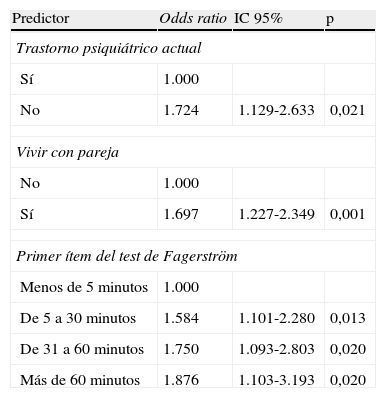Evaluar los factores predictivos de éxito del tratamiento telefónico del tabaquismo.
Pacientes y métodosEstudio observacional realizado en el contexto de la práctica clínica en una Unidad de Tabaquismo. Programa de tratamiento por teléfono durante 3 meses y seguimiento hasta los seis meses. Se analizaron variables sociodemográficas, de dependencia y comorbilidad, y como variable principal la abstinencia continua a las 24 semanas.
ResultadosSe incluyeron 743 sujetos (43% varones y 57% mujeres), con edad media (DE) de 41,9 (9,8) años. La abstinencia continua fue del 37,3% (intervalo de confianza del 95% [IC 95%] 34,9-40,0). El modelo multivariable mostró tres variables con valor predictivo: no padecer trastorno psiquiátrico, vivir en pareja y el primer ítem del test de Fagerström.
ConclusionesEl resultado del programa de tratamiento estuvo condicionado por las siguientes variables del fumador: la dependencia a la nicotina, la patología psiquiátrica y el soporte social.
To identify the predictors of successful outcome in a telephone smoking cessation program.
Patients and methodsObservational study in the context of clinical practice in a smoking cessation clinic. The smoking cessation program was carried out by phone over a period of 3 months and follow-up for 6 months. Sociodemographic variables were analyzed, dependence, and comorbidity and the main variable was continuous abstinence at 24 weeks.
Results743 smokers, 43% male and 57% female, mean (SD) age: 41.9 (9.8) years. The continuous abstinence rate at 24 weeks was 37.3% (IC 95% 34.9-40.0).The multivariable model showed three variables with predictive value: no current psychiatric diagnosis, social support and the first item of Fagerström test (time to first cigarette in the morning).
ConclusionsTreatment outcomes of this smoking cessation program was influenced by the following variables: nicotine dependence, psychiatric disorders and social support.
Artículo
Comprando el artículo el PDF del mismo podrá ser descargado
Precio 19,34 €
Comprar ahora








